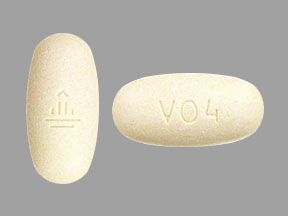Viramune XR Disease Interactions
There are 4 disease interactions with Viramune XR (nevirapine).
NVP (applies to Viramune XR) hepatotoxicity
Major Potential Hazard, High plausibility. Applicable conditions: Liver Disease
The use of nevirapine has been associated with severe, life-threatening, and fatal hepatotoxicity, particularly in the first 18 weeks of therapy. Fulminant and cholestatic hepatitis, hepatic necrosis, and hepatic failure have been reported. Nevirapine-induced hepatitis and hepatic failure may be associated with signs of hypersensitivity, which can include severe rash or rash accompanied by fever, general malaise, fatigue, muscle or joint aches, blisters, oral lesions, conjunctivitis, facial edema, eosinophilia, granulocytopenia, lymphadenopathy, or renal dysfunction. In controlled clinical trials, symptomatic hepatic events regardless of severity occurred on average in 4% (range 0% to 11%) of patients who received nevirapine and 1.2% of patients in control groups. The risk was greatest in the first 6 weeks of therapy and continued to be greater in the nevirapine groups compared to controls through 18 weeks of treatment. In general, the patients at greatest risk of hepatic events are women with high CD4 counts. During the first 6 weeks of treatment, women have a 3-fold higher risk than men for symptomatic, often rash-associated, hepatic events (5.8% vs. 2.2%). In a retrospective review, women with CD4 counts greater than 250 cells/mm3 had a 12-fold higher risk of symptomatic hepatic events compared to women with lower CD4 counts (11% vs. 0.9%). A 5-fold increased risk was observed in men with CD4 counts greater than 400 cells/mm3 compared to men with lower CD4 counts (6.3% vs. 1.2%). Additionally, coinfection with hepatitis B or C and/or increased liver function tests at the start of therapy are associated with a greater risk of later symptomatic events (6 weeks or more after starting nevirapine) and asymptomatic increases in AST or ALT. Therapy with nevirapine should be administered cautiously in patients with preexisting liver disease or liver function test abnormalities. Due to the risk of drug accumulation, nevirapine should not be administered to patients with severe hepatic impairment. All patients treated with nevirapine should undergo intensive clinical and laboratory monitoring (i.e., once a month or more) during the first 18 weeks of therapy, and regular monitoring thereafter. Liver function tests should be performed at baseline, prior to dose escalation, and at two weeks post-dose escalation. Patients should be instructed to discontinue nevirapine and seek medical attention promptly if signs and symptoms of hepatic injury or hypersensitivity develop such as fever, pruritus, rash, facial edema, anorexia, nausea, vomiting, fatigue, right upper quadrant pain, dark urine, and jaundice. Nevirapine should be permanently discontinued if clinical hepatitis or transaminase elevations combined with rash or other systemic symptoms occur, and should not be restarted after recovery. In some cases, hepatic injury progresses despite discontinuation of treatment.
NVP (applies to Viramune XR) rash
Major Potential Hazard, High plausibility. Applicable conditions: Dermatitis - Drug-Induced
Nevirapine can cause severe, life-threatening skin reactions such as Stevens-Johnson syndrome, toxic epidermal necrolysis, and hypersensitivity reactions characterized by rash, constitutional findings, and organ dysfunction including hepatic failure. Fatalities in association with these reactions have been reported. The first 6 weeks of therapy is the period of greatest risk, and intense monitoring is recommended during the first 18 weeks. In controlled clinical trials, Grade 3 and 4 rashes were reported during the first 6 weeks in 1.5 % of nevirapine-treated patients compared to 0.1% of placebo subjects. Patients who develop signs or symptoms of severe skin reactions or hypersensitivity reactions possibly related to nevirapine at any time during therapy must discontinue the drug and seek medical attention immediately. Because nevirapine-induced hepatitis and hepatic failure may be associated with hypersensitivity reactions, liver function tests should be performed in these patients as well as all patients who develop a rash within the first 18 weeks of treatment. Nevirapine should be permanently discontinued if clinical hepatitis or transaminase elevations combined with rash or other systemic symptoms occur, and should not be restarted after recovery. Nevirapine therapy should also not be restarted following severe skin or hypersensitivity reactions or a rash that is accompanied by fever, general malaise, fatigue, muscle or joint aches, blisters, oral lesions, conjunctivitis, facial edema, eosinophilia, granulocytopenia, lymphadenopathy, or renal dysfunction. During the initial 2-week lead-in period of 200 mg/day (4 mg/kg/day in pediatric patients), the dosage of nevirapine should not be increased if any rash occurs. Dose escalation should only be attempted after the rash resolves.
NVP (applies to Viramune XR) hemodialysis
Moderate Potential Hazard, High plausibility.
Nevirapine is partially removed by hemodialysis. In a pharmacokinetic study of nevirapine in patients with renal impairment, six subjects requiring hemodialysis exhibited a 44% reduction in nevirapine systemic exposure (AUC) over a one-week period. There was also evidence of accumulation of nevirapine hydroxy-metabolites in plasma in these patients; however, the clinical significance is unknown. A supplemental dose following each dialysis session is indicated for patients undergoing chronic hemodialysis.
NVP (applies to Viramune XR) renal dysfunction
Moderate Potential Hazard, High plausibility.
Nevirapine metabolites are primarily eliminated by the kidney. The clinical significance of possible reduced metabolite clearance in renal impairment is uncertain. Therapy with nevirapine should be administered cautiously in patients with renal impairment.
Switch to professional interaction data
Viramune XR drug interactions
There are 451 drug interactions with Viramune XR (nevirapine).
More about Viramune XR (nevirapine)
- Viramune XR consumer information
- Check interactions
- Compare alternatives
- Drug images
- Side effects
- Dosage information
- During pregnancy
- Drug class: NNRTIs
- Breastfeeding
Related treatment guides
Drug Interaction Classification
| Highly clinically significant. Avoid combinations; the risk of the interaction outweighs the benefit. | |
| Moderately clinically significant. Usually avoid combinations; use it only under special circumstances. | |
| Minimally clinically significant. Minimize risk; assess risk and consider an alternative drug, take steps to circumvent the interaction risk and/or institute a monitoring plan. | |
| No interaction information available. |
See also:
Further information
Always consult your healthcare provider to ensure the information displayed on this page applies to your personal circumstances.


